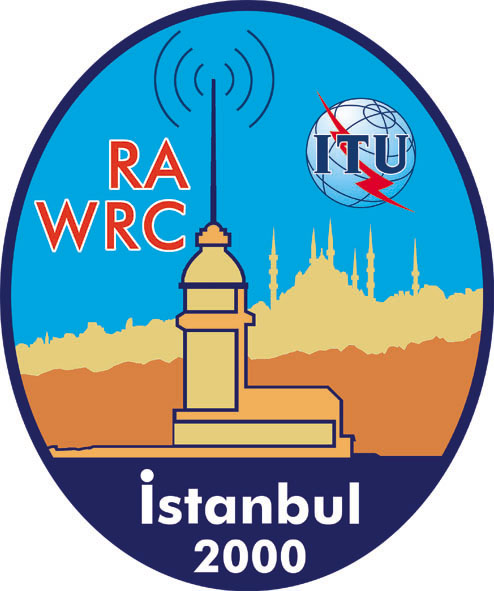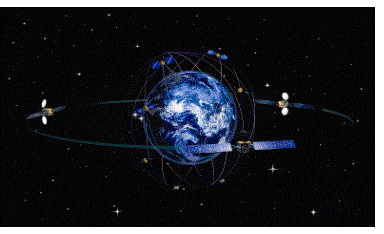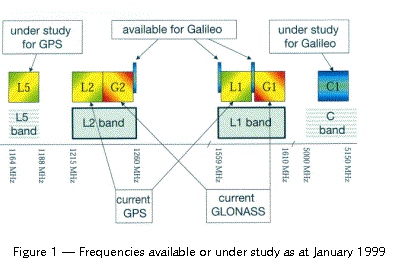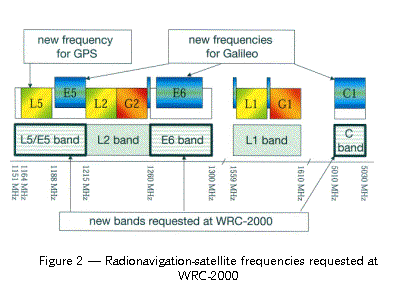
World Radiocommunication Conference 2000
Telephone: +41 22 730 6039
Fax: +41 22 730 5939
E-mail: pressinfo@itu.int
 |
World Radiocommunication Conference 2000 |
|
Telephone: +41 22 730 6039 |
Frequencies for "Galileo"!
Fran�ois Rancy, Director, Spectrum Planning and International
Affairs
Jean-Dominique Rolfo, Deputy Director, Spectrum Planning and International
Affairs
J�r�me Michelet, Expert on radionavigation-satellite systems
Agence nationale des fr�quences (ANFR)
Radionavigation needs: unlimited demand vs. inadequate availability
Radionavigation-satellite applications (positioning, synchronization, etc.) have evolved at a tremendous rate since the appearance of the United States' Global Positioning System (GPS), to the extent that they are now almost too numerous to list on a single page. The annual market is worth an estimated tens of billions of euros, and is set to give rise to over 100 000 direct jobs. Current needs are barely satisfied by the GPS, which is on the way to becoming a near-monopoly vis-�-vis its Russian competitor, the Global Navigation Satellite System (GLONASS). These two systems, originally set up to serve the needs of the government, are ill-adapted to the needs of the most demanding civil applications, especially those related to civil aviation.
Europe (as represented by the European Commission, with the support of the European Space Agency (ESA)) is responding to the situation by setting up a multinational civil project called Galileo, which should be meeting the full range of needs as from 2008.
This is excellent news for future users, as the services on offer will reflect the diversity of, and competition between, the different systems. It could also be a dream come true for civil aviation, with the advent of GNSS-2 (second-generation global navigation satellite system), a "system of systems", in which the different satellite navigation techniques are merged to obtain a considerably enhanced service, capable in some cases of replacing all ground-based navigation equipment.
 |
| GalileoSat (Artist�s impression). Galileo is intended to enable Europe to become a major partner in the setting up of a civilian satellite service around 2008. This service will meet worldwide the multimodal navigation requirements and can operate either autonomously or together with other systems. Aeronautical, maritime and land mobile users are expected to benefit greatly from the service. (Photo ESA/J.Huart). |
A ground-breaking quest for frequencies
The United States, which already has the use of two broad frequency bands for its GPS, is now seeking a third band in an attempt to meet the particularly heavy demands of civil aviation. The Europeans, who currently only have access to the few remaining bands, which are too narrow, are also seeking several broad bands capable of accommodating Galileo (which has taken over from the L-SATNAV, M-SATNAV and E-GNSS1 projects). The results obtained in early 1999 were hardly encouraging, with only a single band having been identified, the high frequency (5 GHz) of which entailed major technological constraints, and whose limits came far from achieving unanimous support.
However, on 25 January 1999, the Americans surprised everyone by deciding to establish themselves firmly within a band called L5 (1 164-1 188 MHz), which is densely occupied by navigation equipment using DME (distance measuring equipment) instruments, as well as by government equipment (see Figure 1). It gradually became clear that the new signal would only tolerate a limited number of DMEs and that, in several parts of the world, the excess DMEs had to be withdrawn. This seems paradoxical, given that the signal in question is supposed to assist civil aviation! In Europe, which has the highest number of DMEs, operating in L5 could in certain cases be impossible were it to prove unfeasible to withdraw enough DMEs.
 Shortly
afterwards, on 10 February 1999, the European Commission unveiled the broad
outline of its Galileo project. Besides being a free public service comparable
to GPS, it is intended to be even more efficient than GPS L5 in meeting air
transport needs. Moreover, we have here the introduction of an innovative
concept in the form of a made-to-measure commercial service for users with
particular requirements.
Shortly
afterwards, on 10 February 1999, the European Commission unveiled the broad
outline of its Galileo project. Besides being a free public service comparable
to GPS, it is intended to be even more efficient than GPS L5 in meeting air
transport needs. Moreover, we have here the introduction of an innovative
concept in the form of a made-to-measure commercial service for users with
particular requirements.
Unfortunately, owing to a lack of available frequencies, the project was in danger of not being able to fulfil its declared aims. In particular, an L5-type solution seemed out of the question as long as the excess DMEs could not be removed.
Squaring the circle
However, a means of resolving the problem of compatibility between satellite navigation and DMEs was found in June 1999. It involves a two-bandwidth signal concept (referred to as "broadband/narrow-band"), which allows for signal reception to be adjusted according to the number of DMEs. This means that an adequate radionavigation service can be ensured while avoiding interference to DMEs. Preliminary studies have confirmed the promising potential of this concept.
Since then, two opposing schools of thought on the matter have been confronting each other in the different ITU forums:
�
On the one hand there is the "minimalist" approach, according to which the introduction of radionavigation in the band used by DMEs would be harmful to the latter, it therefore being necessary to reduce the intrusion at all costs.�
On the other hand there is the "protectionist" approach, according to which the new radionavigation-satellite services are perfectly able to adapt to the DMEs, whose regulatory protection needs to be confirmed, even if this means opening the band up further to the new services in order to provide them with all the flexibility they require.In the course of the debates, which have continued for several months and have often been heated, the advocates of the second solution have gradually convinced increasing numbers of the aptness of their approach.
Furthermore, one of the two bands already open to satellite navigation, the so-called L2 band (1 215-1 260 MHz), can readily be extended towards the adjacent band, which is likewise mainly occupied by radars. Protection of the radars has been taken into account in the planned extension, but this raises the question of the protection of these same radars in the initial band; the issue remains open and promises to give rise to some interesting developments.
Finally, after a few tentative trials with current users, a satisfactory band was found in the vicinity of 5 GHz. New horizons have thus been opened up for the frequencies needed by Galileo. In October 1999, the European Commission confirmed the suitability of the frequencies envisaged for its project.
Unbridled creativity
Since the end of 1999 the minds behind Galileo have been highly imaginative in their efforts to make optimum use of the various frequency options available to them. In particular, the broadband/narrow-band concept is surpassing itself by generating a number of unexpected developments. Creativity is in full swing.
 The 2000 World Radiocommunication Conference will represent an opportunity to
provide satellite navigation with the frequencies it needs to meet its goals
(see Figure 2): a band for a joint GPS and Galileo service which is set to
launch civil aviation into the twenty-first century, and two further bands
which, by providing Galileo with a degree of access equivalent to that enjoyed
by GPS, will enable it to play a part in the wider range of services being
offered for the greater satisfaction of everyone's needs.
The 2000 World Radiocommunication Conference will represent an opportunity to
provide satellite navigation with the frequencies it needs to meet its goals
(see Figure 2): a band for a joint GPS and Galileo service which is set to
launch civil aviation into the twenty-first century, and two further bands
which, by providing Galileo with a degree of access equivalent to that enjoyed
by GPS, will enable it to play a part in the wider range of services being
offered for the greater satisfaction of everyone's needs.